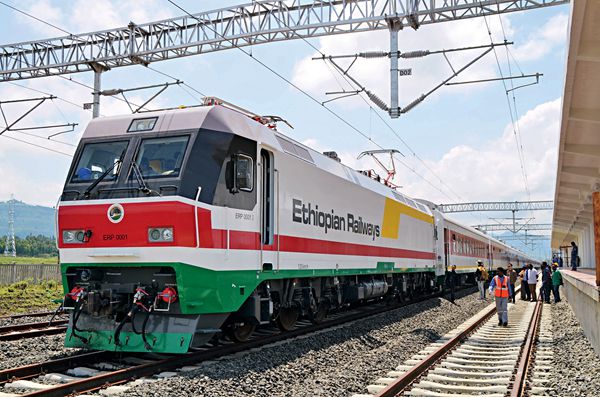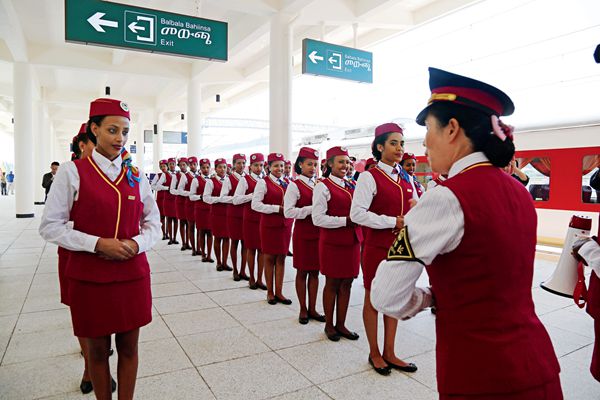Enhancing Connectivity in East Africa: The Addis Ababa-Djibouti Railway
By staff reporter LU RUCAI
ON October 5, 2016, the Addis Ababa-Djibouti Railway was opened at Labu Station, marking its official launch of operations. Built by the China Railway Engineering Corporation (CREC) and China Railway Construction Corporation (CRCC), the railway links the Ethiopian capital Addis Ababa with the port of Djibouti, one of the largest ports in East Africa.

Chinese workers cheer at the Addis Ababa–Djibouti Railway project inauguration ceremony on October 5, 2016.
Africa’s First Transnational Electrified Railway
Fu Xun is the general manager of the CREC’s Addis Ababa-Djibouti Railway project. Since coming to Ethiopia in 2012, he has witnessed the whole construction process from beginning to end.
“The railway is capable of slashing journey times between Addis Ababa and Djibouti from seven days by road to around 10 hours,” said Fu. Since graduating from Changsha Railway University in 1985, the railway engineer has been on the frontline of construction in China.
Fu could not remember the number of railway construction projects he has been involved in over the past three decades, but the Addis Ababa-Djibouti Railway, he said, would be the one he is most proud of and one he will certainly never forget.

A train sets out on a test run along the Addis Ababa–Djibouti Railway on August 15, 2016.
A total investment of US $4 billion was put into the project, which used Chinese-made equipment and standards. The 752.7 km railway has 45 stations and trains are designed to run at speeds of up to 120 km per hour. This is the first overseas railway built solely by Chinese enterprises and many different Chinese companies were involved in the project: The Export-Import Bank of China provided funding; CREC was the EPC (engineering, procurement and construction) contractor; and China International Engineering Consulting Corporation acted as consultant and supervisor.
The railway is the second transnational railway built by Chinese firms in Africa. The first was the Tazara Railway built in the 1970s, linking Dar es Salaam in Tanzania with Kapiri Mposhi in Zambia. During a visit to Ethiopia in May 2013, Chinese Vice Premier Wang Yang hailed the Addis Ababa-Djibouti Railway as the “Tazara Railway for a new era.” Yet unlike the Tazara Railway, which was funded by the Chinese government, the Addis Ababa-Djibouti Railway is a commercial venture by Chinese firms.
When Ethiopia first decided to build a new railway, they invited experts from Switzerland, Australia, and other developed countries to conduct a survey. The experts, from a technical point of view, concluded that constructing an electrified railway from the flat desert land around Djibouti right up to the Ethiopian Plateau was an impossible task.
CREC took the initiative, contacting Ethiopian officials with geological and hydrological data for the proposed route, collected by technicians with China Railway No. 2 Group and China Railway Eryuan Engineering Group. Using their rich experience in railway construction, the two groups submitted a high-quality project feasibility report and preliminary design plan to the Ethiopian Railway Company, which eventually won them the EPC contract.
During construction, the Chinese engineers and workers managed to find solutions to other problems too, such as a lack of supplies locally, long transit times for imported equipment and goods, poor medical facilities, different customs, not to mention the language barrier. In the space of only 48 months – from the time construction commenced in October 2012, to the official inauguration four years later – a modern electric railway was unveiled to the peoples of both nations. The track-building took only 13 months, which was a new record in rail construction.
Benefits for Local People
Iman, a young Ethiopian woman, has never travelled by train before, but will work as purser on the new railway when it begins commercial operations. Her family is proud of her role on Africa’s first electrified railway.
Iman’s brother is an engineer and in 2013 was employed to work on the gauging of the Addis Ababa-Djibouti Railway project. This made Iman determined to be part of the project too. After graduating in 2016, she undertook crew training provided by CREC and made quick progress, gaining employment with the railway.

Customer service attendants on the Addis Ababa–Djibouti Railway undertake training.
According to Fu Xun, nearly 40,000 local workers were hired during the construction of the railway. After the official opening, a consortium formed by CREC and the China Civil Engineering Construction Corporation will manage railway operations for six years. The project will also employ more than 2,000 local workers in freight and passenger traffic, locomotive maintenance, infrastructure maintenance, and other areas.
Give a man a fish and he eats for a day. Teach him how to fish and he eats for a lifetime. The Chinese government and Chinese companies stressed the importance of training local engineering talent during the railway’s construction. More than 300 employees of the Ethiopian Railway Company visited universities and technical schools in Beijing, Tianjin, and Chengdu to further their professional knowledge of railway engineering, train driving, and track maintenance.
Tadesse is one of the drivers with the Ethiopian Railway Company who was selected from hundreds of candidates to receive professional training in China. After a year in China, he returned Ethiopia to continue his studies with the help of instructors at CREC. Tadesse is now qualified to drive a train without supervision. He appreciated the in-depth training given by Chinese conductors and drivers, and hopes to be an exemplary train driver in the future. A total of 136 Ethiopian railway workers trained in China will be employed on the railway.
Chinese railway engineers embraced the task of improving infrastructure and public services as just another part of their job in Ethiopia. Ethiopia has a profusion of underground water sources, but this natural resource was not efficiently utilized. In the dry season, people in remote areas struggled to access a water supply. They had to travel several miles just to locate small ponds left after rainy days. To create a clean supply of drinking water for people living along the railway, CREC sent water trucks, installed a pipe outside their camp for the benefit of nearby villages and dug wells for free where conditions permitted.
Chinese firms have developed a trusting relationship with local people by performing charitable acts such as making donations to students, doing classroom repairs, greening and constructing roadbed. CREC has built more than 400 kilometers of road, constructed 19 wells, established 20 distribution sites providing drinking water to villages, and repaired over 2000 sq meters of school playground.
A severe drought occured at the end of 2015, leaving more than eight million people in urgent need of emergency food supplies. A number of different countries and international organizations sent aid shipments to Ethiopia, including China, but these supplies became stranded in the port of Djibouti due to problems with road transport. At the request of the Ethiopian government, Chinese companies immediately developed a plan for temporary freight transportation. They decided to make the Addis Ababa-Djibouti Railway operational ahead of time, and delivered more than 100,000 tons of emergency supplies with the diesel locomotives used for construction.
Boosting Development in East Africa
The Addis Ababa-Djibouti Railway has been hailed as a “lifeline program.” Landlocked Ethiopia relies on the Red Sea ports of its neighbor, Djibouti, as its main gateway for imports and exports. This traffic makes up a staggering 90 percent of the throughput at Djibouti’s ports. The only land route is a dilapidated road with limited capacity and journeys can take up to a week. The new railway will reduce journey time to 10 hours and will become the main channel for the export of goods and travel between Ethiopia and the rest of East Africa.
Xu Shaoshi, special envoy of Chinese President Xi Jinping and head of the National Development and Reform Commission, attended the opening of the Addis Ababa-Djibouti Railway. He said the railway – as the first transnational electrified railway in Africa – was a milestone in the development of Ethiopia and Djibouti. For China it represents a symbolic achievement of the Belt and Road Initiative and stands as a landmark project for Sino-African cooperation in building the “three major networks” (railways, roads, and regional aviation) to enable industrialization. The railway will be a catalyst for development in Ethiopia and Djibouti.
The Prime Minister of Ethiopia, Hailemariam Desalegn, and Ismail Omar Guelleh, the President of Djibouti, respectively expressed their hopes that the Addis Ababa-Djibouti Railway would significantly promote the economic development of both countries and create an economic corridor along the route. With more development opportunities in these regions, East Africa is all set for a bright new look.
